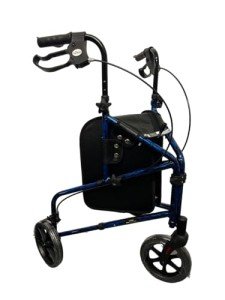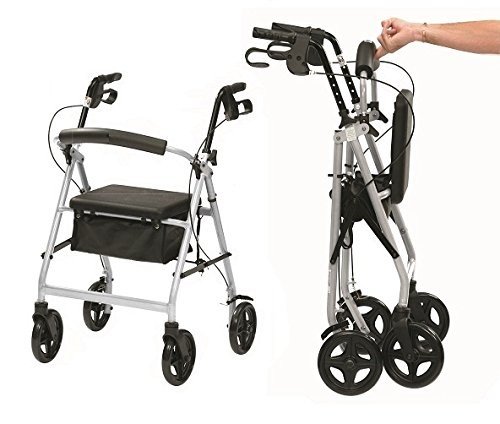
Outdoor Walker
Add a review FollowOverview
-
Founded Date 28/09/2024
-
Sectors Sales & Marketing
-
Posted Jobs 0
-
Viewed 14
Company Description
10 Things That Everyone Is Misinformed About The Word “Rollator For Walking”

Understanding Rollators for Walking: A Comprehensive Guide
Rollators are an indispensable mobility aid that improves the flexibility and self-reliance of those with restricted walking abilities. They are created not only to provide stability and assistance but likewise to motivate COSTWAY Folding Mobility Walker: Seat & Storage and engagement in daily activities for people of any ages. This article delves deep into the world of rollators, offering insights into their features, benefits, types, maintenance, and crucial considerations when picking the most appropriate design.
What is a Rollator?
A rollator is a mobile walking aid equipped with four wheels, handgrips, a seat, and typically includes additional features such as storage baskets and brakes. Unlike conventional walkers, which require the user to lift them off the ground, rollators can be pressed along as the user walks, making them especially beneficial for individuals with restricted strength or balance.
Secret Features of Rollators
Rollators consist of numerous functions that improve their use:
- Wheels: Most rollators include swivel or repaired wheels for better maneuverability inside your home and outdoors.
- Brakes: Hand brakes permit users to manage their speed and stop securely.
- Seat: Many rollators offer an integrated seat for users to rest when needed.
- Ultra Lightweight 3 Wheel Rollator with Bag Frame: Constructed from lightweight materials, rollators are easy to lift and carry.
- Adjustable Height: Most rollators enable height changes to accommodate the user’s stature.
Benefits of Using a Rollator
Using a rollator uses many benefits, particularly for seniors and individuals with mobility obstacles. These may consist of:
- Improved Stability: Rollators supply a steady base that assists avoid falls.
- Increased Mobility: Users can move about more easily, whether inside your home or outdoors.
- Boosted Independence: With a rollator, users can carry out everyday jobs without requiring help.
- Practical Seating: The schedule of a seat enables users to rest whenever they feel tired.
Types of Rollators
When thinking about which rollator to select, it’s important to acknowledge the different types readily available. The primary categories include:
- Standard Rollators: Typically have 4 wheels and a seat, ideal for a lot of indoor and outdoor environments.
- Durable Rollators: Designed for bigger people, these rollators have enhanced frames and higher weight capabilities.
- Three-Wheel Rollators: These provide a more lightweight and compact option, making them ideal for narrower areas.
- Foldable Rollators: Convenient for transport, these designs can be quickly collapsed and saved when not in use.
| Type of Rollator | Description | Best For |
|---|---|---|
| Standard Rollator | 4 wheels, seat, numerous alternatives. | General use, indoor and outdoor. |
| Durable Rollator | Enhanced for greater weight capability. | Larger individuals requiring additional support. |
| Three-Wheel Rollator | Compact and lightweight, easy to maneuver. | Minimal space and indoor use. |
| Foldable Rollator | Collapsible for easy transport. | Regular tourists or caregivers. |
How to Choose the Right Rollator
Choosing the best rollator involves thinking about a number of factors to satisfy the individual’s specific requirements:
- Weight Capacity: Ensure the rollator can support the user’s weight.
- Height Adjustability: Look for models that can be changed to the user’s height for optimal Drive Devilbiss Tri-Walker: Comfort & Support on the Go.
- Features Needed: Consider whether extra features like baskets, trays, or hand brakes are very important.
- Intended Use: Determine if the rollator will be mostly used inside, outdoors, or both.
Maintenance Tips for Rollators
To extend the lifespan and functionality of a Rollator With Seat, regular maintenance is essential. Here are some beneficial suggestions:
- Check Brakes: Regularly test brakes to guarantee they engage appropriately.
- Inspect Wheels: Look for indications of wear and tear; wheels ought to roll smoothly.
- Tidy Regularly: Wipe down the frame and elements to prevent dirt buildup.
- Tighten up Bolts: Periodically check and tighten up any loose bolts or screws.
Often Asked Questions (FAQs)
1. Can rollators be used on unequal surface areas?
Yes, numerous rollators are developed with larger wheels or specialized treads to manage uneven surfaces. Nevertheless, users should work out caution and guarantee they feel stable when navigating such surfaces.
2. How do I determine the correct height for a rollator?
When standing straight, the handles of the rollator should align with the user’s wrist when their arms are unwinded at their sides. This position ensures comfortable use.
3. Do I need a prescription to buy a rollator?
No, rollators can be bought without a prescription. Nevertheless, consulting a healthcare professional can be helpful to determine the very best alternative based on individual requirements.
4. Are rollators covered by insurance coverage?
Coverage for rollators can differ based upon the type of insurance strategy. Lots of Medicare plans provide coverage for some types of walkers, consisting of rollators. It’s recommended to consult the insurance coverage service provider straight.
Rollators for walking considerably improve the lives of lots of individuals dealing with mobility difficulties. Offering stability, self-reliance, and ease of movement, they act as crucial tools for preserving an active way of life. Understanding the various types, functions, and how to keep them in good condition can empower users in making notified choices. As mobility requirements vary greatly from individual to individual, it is vital to choose a rollator that best fulfills private requirements and boosts quality of life.



